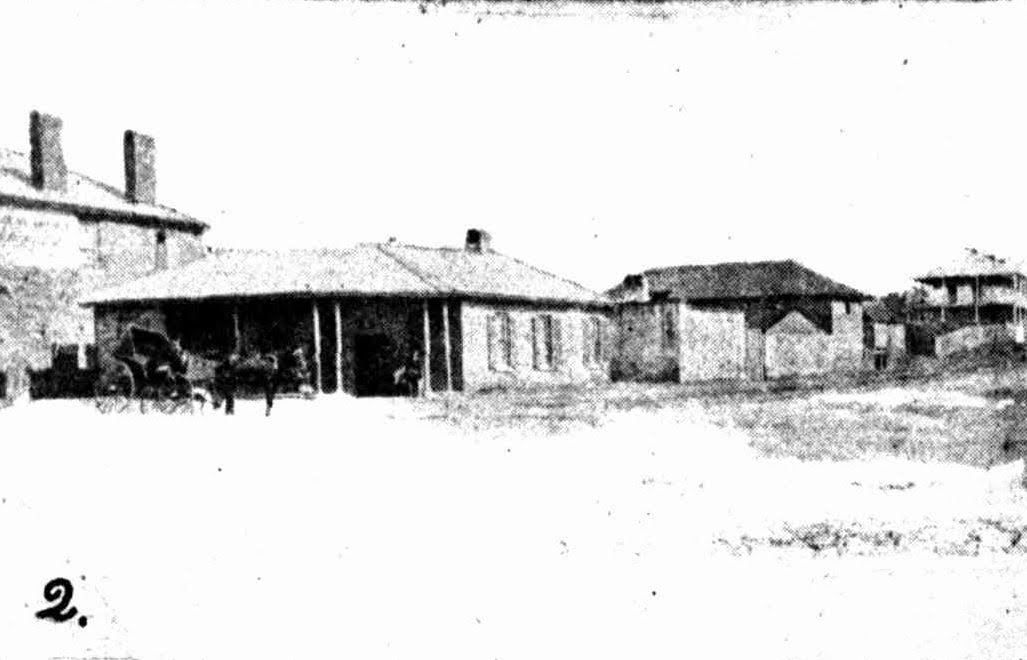
[John Taylor Remembers, in the 1830s] … this was a famous hostelry kept by James Smith, 70 years ago, on the site now occupied by Washington Soul’s establishment. The old stables at the rear were the livery stables when the house was kept by Mr. James Watsford, father of the Rev. John Watsford. In the distance stands the old hospital.
The coaches started from the Cross Keys every morning for Sydney and the great whips of those days were James and Henry Watsford (the latter the father of our present stationmaster). Coaches also ran from Windsor to Sydney in those days. They changed horses at the Australian Arms Hotel stables at the rear of the present Bank of New South Wales. After changing horses the coaches went on to Sydney. They arrived in Sydney early enough to allow of changing and then starting from Parramatta at 6.a.m., and reach Sydney at 8.a.m. with the mails and passengers.
Old Weller (possibly related to Sam Weller) and Harry Mortimer (whose sons now reside at Auburn) were the whips who tooled the Windsor team from Windsor to Sydney and back. More than once had they to bail up on the Old Windsor road, for this was a great haunt of the bushrangers.
Talking about the bushranging days, John Thorne was the chief constable here then. The smiling district of Thornleigh is named after him. When the bushranger MacNamara and his notorious mate were on the road, their rendezvous was at the caves at the rear of Colonel Burns’ residence, near the waterworks. From there they used to sally out and waylay their men on the Windsor road. Dr. William Sherwin, who served his time with Dr. Bland of Sydney, was the first private medical man to settle in Parramatta.
He came here at the request of the whole populace, and settled in Macquarie Street, in a house afterwards occupied by Mr. John Taylor, and now used as a boarding house. This house was built by John Batman, father of the founder of Port Phillip. Well, to return to Dr. Sherwin. Near the Windsor-road, just above the Darling Mills, and the other side of Mr. Chisholm’s cottage, there was a long weatherboard public house which lay back from the road. A little above that MacNamara and his mate came out and bailed the doctor up; demanding his money.
The doctor told them he never carried cash about him when going in that direction.
“Well, doctor,” said the bold Mac,
“You have a watch, and we want that, so hand it over.”
The doctor told him that it was an old relic, and not worth much.
“How much?” said Mac.
“Well, about £3,” said the doctor.
“Well,” said Mac, “we will accept your valuation. Hand over the ticker, and if you desire to redeem it, you bring the money and give a certain signal, and you can have your watch back again.”
To this the doctor assented, and riding back he borrowed the money at the public house called the Green Gate, kept by old Mr. Ashby, at the corner of the North Rocks road and the Windsor-road. Then he road back, gave the signal, paid over the money, and got his watch back. Having thus kept faith with the robbers, he then considered himself relieved from any further obligation, so he rode back to Parramatta and reported the matter to the police, whereupon Constable Thorne, chief constable, accompanied by Constable Horn, next in command, with others, went out.
The police did not wear uniform in those days. Well, they met the highwaymen and had a conflict, in which one highwayman was shot dead, and the other taken prisoner, and afterwards executed. Sir George Gipps, who was Governor, then residing in Parramatta, highly commended John Thorne as an Australian, and called upon all Australians to take pattern by him. That was in a proclamation, published in the “Sydney Gazette.” Thorne was granted 640 acres of land at Pennant Hills, and close by Horne got 320 acres.
The land was held for many years by the Thorne family, until the winding up of the estate, when Mr. John Taylor sold Mr Thorne’s 640 acres to Mr. James Bellamy, sen. The land was afterwards cut up and sold at per acre. Horne’s land – now known as Hornsby – was 40 years back at £3 15s per acre; now it is being re-sold at over £100 per acre, all within the recollection of one man. There we have the history of Hornsby and Thornleigh.
![]() Compiled by Chrissie Crispin, Volunteer, Parramatta City Council Heritage Centre, 2015
Compiled by Chrissie Crispin, Volunteer, Parramatta City Council Heritage Centre, 2015
References
The Cumberland Argus and Fruitgrowers Advocate, Saturday 14 December 1901


